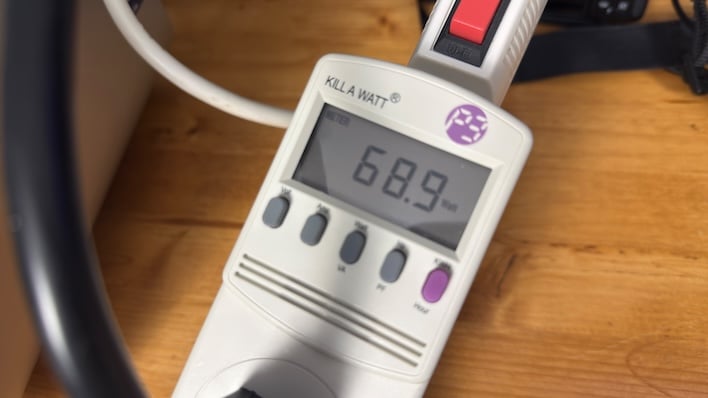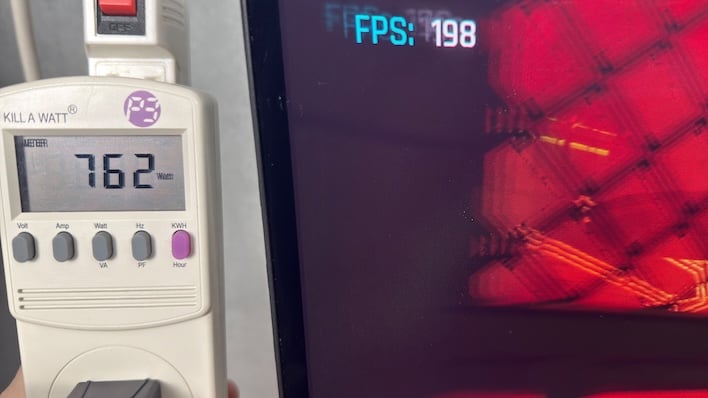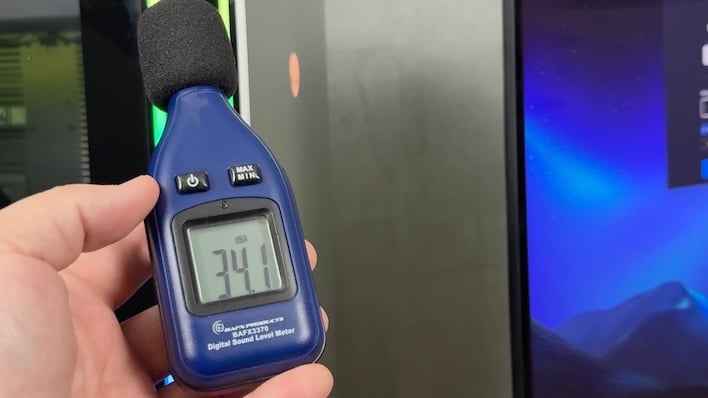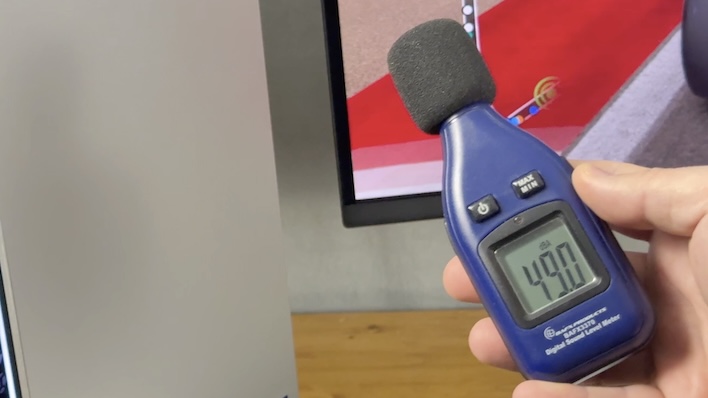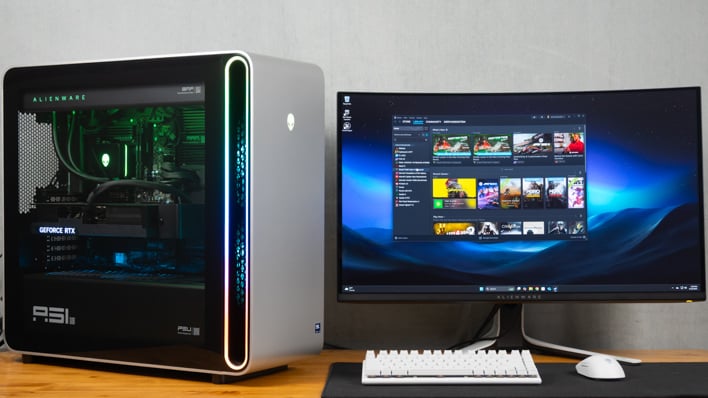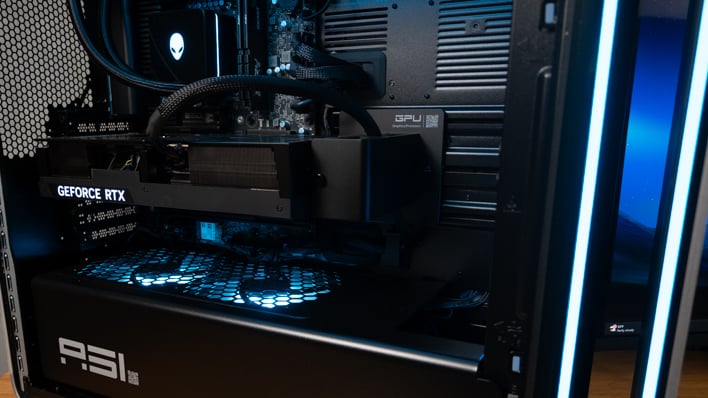Alienware Area-51 (2025) Review: Thermals, Cooling, Acoustics, And Our Conclusion
We know that the Alienware Area-51 offers a lot of performance, and physics demands that all of that performance requires a comensurate amount of energy consumption. And all that energy has to go somewhere, often turning into heat. We also know, however, that the engineering brains behind the system have put a lot of thought into the positive-pressure fan system, so let's take a look at how the Area-51 performs from an energy and thermal perspective.
Alienware Area-51 Thermals And Acoustics
First of all, the Area-51 uses a relatively small amount of power at idle. The power supply is highly rated, which means that even at a small fraction of its 1,500 W capacity, it isn't drawing a ton of energy at the socket. From an idle state, we recorded the Area-51 as consuming between 65 and 75 Watts (depending on whether a background task spins up in the moment). If you flip back to our GeForce RTX 5090 review, that's actually quite a bit less than our testbeds.
Total power consumption under a gaming load is also quite good, relatively speaking. For this test, we powered up the canned benchmark in Cyberpunk 2077 and ran it several times to get everything as warmed up as it can be. Here we actually drew a little bit more under load than our testbeds, but that system is outfitted with a Ryzen 7 9800X3D rather than Intel's Arrow Lake-based Core Ultra 9 285K. The latter is known for being a bit of a power-hungry processor. But the big draw here is the GeForce RTX 5090, which is a large GPU with tons of memory and just requires a lot of current. Still, 760-ish Watts under load for this combination is what we'd expect from enthusiast-class hardware.
As for noise, the Area-51 is pretty quiet. At idle and from a distance of just 12 inches, it does register on our sound meter, but it's not all that loud. 34-35 dBA is whisper-quiet. All but the most discerning sound-obsessed enthusiast will be very happy with how quiet the Area-51 is when it's idle.
Under load, the system definitely generates more noise. When there's a lot of heat being generated, the fans have to obviously spin faster, and we registered just under 50 dBA from the same distance. At these noise levels, the difference is perceptively much louder. But that's the cost of having high-power hardware in a PC. We think this is actually a quite good result, all things considered. Arrow Lake's teething issues are a thing of the past, and the Area-51 proves that.
Alienware Area-51 Conclusions
There's an eternal struggle between building a desktop PC or buying a pre-built. Those who build will say a pre-built system just costs too much money, or they want to obsess about every cable placement and zip tie that makes it beautiful on the inside. Then again, with the Area-51, Alienware produced a build that's just as neat and tidy as any enthusiast could muster. Not all builders will do that, but when you're competing at a price point that is occupied by boutique builders, it's something the company had to do.The bottom line is, the latest Area-51 performed at the top of the charts in pretty much very test. On top of that, if you've watched the video on the first page, you saw a bunch of other games tested as well. It handles everything beautifully, as it should considering the Core Ultra 9 285K + GeForce RTX 5090 configuration in our review unit. And it did so without compromising on noise or thermals, as you can see above. Everything you'd expect from a high-end gaming PC is present. Add to that upgradability with standard form factor parts, and this is a very nice package.
Of course all the performance and careful thought put into the engineering of the system doesn't come cheap. The Area-51 starts at $3,749 for a configuration with a Core Ultra 7 265K with a 240mm closed-loop cooler, GeForce RTX 5080, 32 GB of RAM, and 1 TB of storage. The retail cost of the GeForce RTX 5080 graphics card might be around $1,000, but the street price these days is around twice that. As a result, the Area-51 might be one of the more affordable ways to get into the top-end of NVIDIA's lineup.
Our review unit with the Core Ultra 9 285K, GeForce RTX 5090, 64GB of RAM, and 2TB of storage is a loftier $5,699. No doubt that's a lot of money, but if you don't enjoy building PCs it does include the labor and assembly, on top of some of the fastest hardware around, and some really good cooling. It also includes a one-year warranty with on-site repairs, which is not something you'd get if you built your own system from parts. In that case you'd be lucky to ship parts to a manufacturer and get replacements in a week or two, so that warranty could come in handy if you need it.
So, is the Alienware Area-51 for you? If you're happy to build your own PC, it probably isn't going to change your mind. On the other hand, if building a new rig is too large of a time commitment or you simply don't have the desire, Alienware offers a very compelling system in the new Area-51. If you opt for a top-of-the-line configuration with all of today's fastest hardware, there's an obvious price premium to consider, but you really do get what you pay for. To quote Ferris Bueller, "It is so choice. If you have the means, I highly recommend picking one up." And for that reason, we're giving the Alienware Area-51 our coveted Editor's Choice award.


